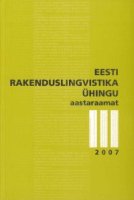Õppijakeel ja eesti vahekeelekorpus
Learner language and Estonian Interlanguage Corpus
Author(s): Helena Metslang, Pille EslonSubject(s): Language and Literature Studies
Published by: Eesti Rakenduslingvistika Ühing (ERÜ)
Keywords: corpus linguistics; interlanguage; learner language corpus; pedagogical grammar
Summary/Abstract: The current article introduces the design, aims and future applications of the Estonian Interlanguage Corpus (EIC) in the background of other learner language corpora in Europe and Asia. Estonian Interlanguage Corpus is an annotated monitor corpus of learner language texts, being created at the chair of General and Applied Linguistics at Tallinn University. It comprises written Estonian language texts, mainly by Russian speakers. The objective of EIC is to support the development of pedagogy and research and of acquisition of Estonian as a second language. EIC is a free online corpus which will by the end of its first stage of development have 500 000 strings of error-annotated texts plus a larger volume of non-annotated texts. The most important tool of EIC is the concordancer which gives flexible search options by various criteria. The specially created error classification has 170 tags and is multidimensional (there are the syntagmatic and paradigmatic axes). To the highest level of tags there belong lexical errors, derivational errors, lexicogrammatical, morphophonological, morphological errors, morphosyntactic, syntactic and communication errors and unspecified errors (ambiguous, doubtful errors). The results of EIC error analysis are a good basis for writing a systematic pedagogical grammar for Estonian as a second language. Analyzing errors statistically and determining the network of links between the errors will help to describe better the system of rules necessary for learning Estonian as a second language. After creating the pedagogical grammar it is possible to build on it syllabi, courses, textbooks, dictionaries and other means to support the process of learning Estonian as a second language.
Journal: Eesti Rakenduslingvistika Ühingu aastaraamat
- Issue Year: 2007
- Issue No: 3
- Page Range: 099-116
- Page Count: 18
- Language: Estonian

